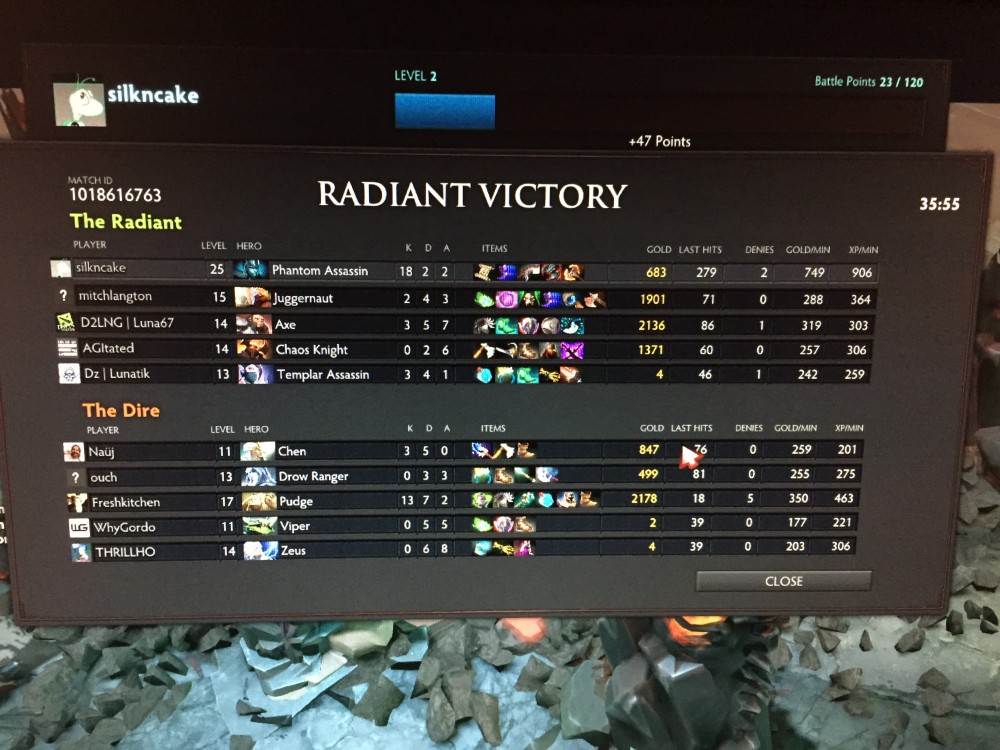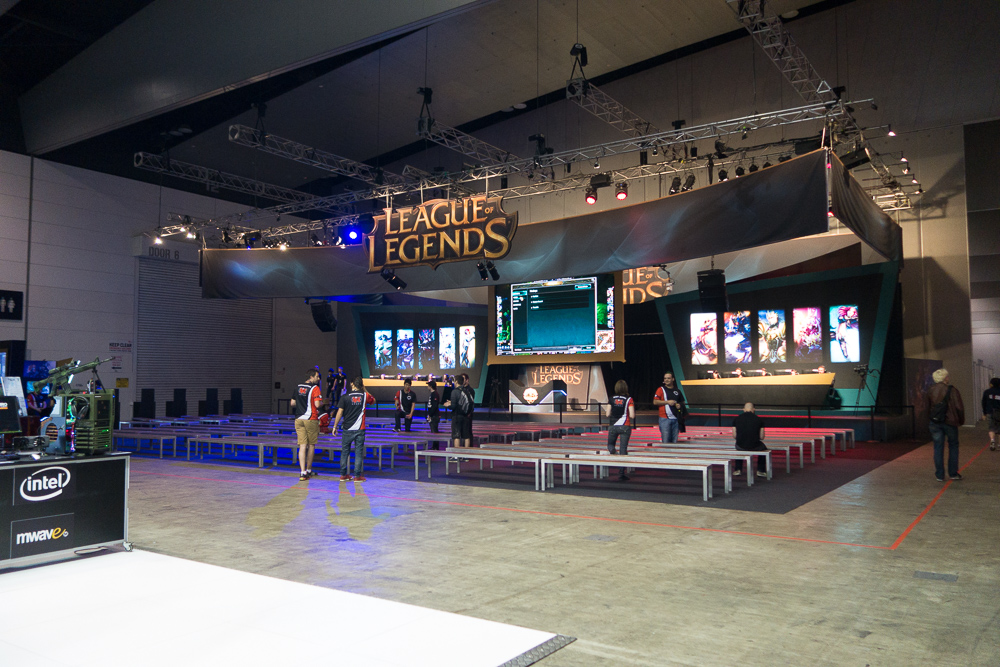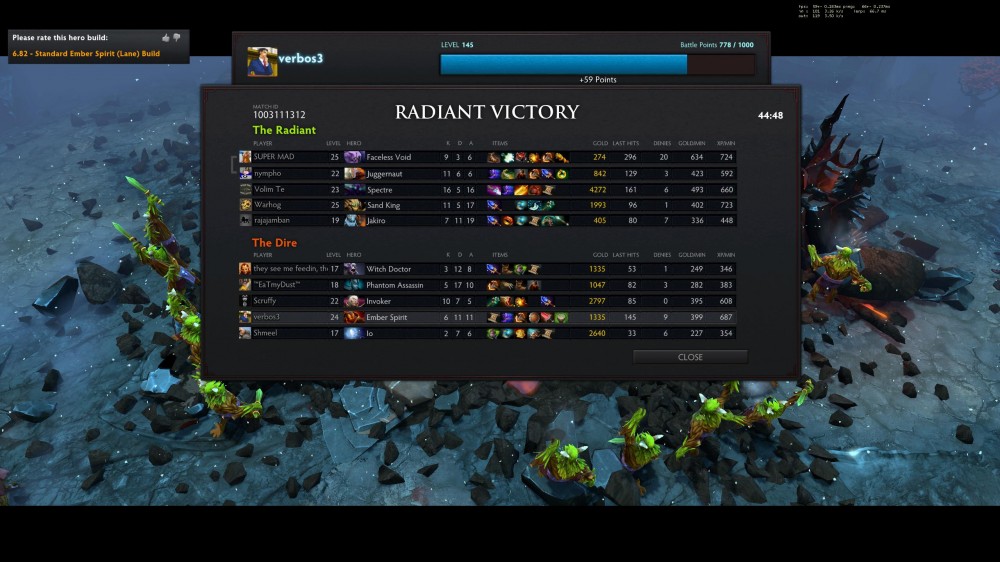Tag Archives: dota 2
What Was That, Bane?
We try Roshan and get initiated on. We kill three and lose two, only to go back, try Roshan again, and give up a double kill to an Earthshaker. It could have gone so much worse…
Critique
For the longest time, I’ve wondered why it’s hard for those who are merely average — myself included — at Dota 2 to improve at the game in any kind of reasonable timeframe.
My own theories revolve around improving at Dota is hard because a lot of the time, you don’t recognise your own mistakes. Whether you’re playing in the so-called “trench-tier”, stuff that wouldn’t work in the pro scene works, and stuff that works in the pro scene doesn’t work in your trench-tier games, mostly because people do (and don’t do) things you wouldn’t expect. It never ceases to amaze me that people who have literally no idea what they’re doing or how the game works can be playing the same game as those who play Dota 2 professionally. It’s completely insane, and totally a topic for another time.
We can probably blame Dota’s “fair and balanced” matchmaking for slow improvement, too. Maybe people just don’t play enough games to notice any real rise in skill, but a lot of the time I feel as though because Dota tries to match you up with and against people who are at the same skill level as you, you often don’t see when you’ve climbed up an MMR bracket, because people will still be, relatively speaking, the same feeding bastards they were when you started out.
Now that I know a little about the game, I’ve often wondered if I should be starting a new Dota 2 account and playing ranked only to see what kind of MMR I end up at. To be fair, it’ll probably be around the same MMR that I am now — how do I know? Because even though I often perceive myself as better at Dota than my teammates, I can’t seem to carry myself out of the rubbish tier I’m in. It’s kind of sad, and is mostly the reason why I don’t play much ranked.
But forget perfect last-hitting mechanics. Forget perfect decision making. If I could choose to be insanely good at just one aspect of Dota 2, it would be in the critique of my own gameplay.
Analysing where you’ve made mistakes is a truly underrated skill, in my opinion. By looking back on games you’ve played and identifying where you could have been more efficient in farming, or where you should have gone through the jungle instead of walking through the river, or where you should have just TP’d out of Dodge as soon as you saw all the other lanes missing, you can learn to improve you own game much more than if you had perfect last hitting mechanics. Perfect decision making would probably help, but if you’re bad at the game to begin with, there’s only so many good decisions you can make, you know?
This ability (or more accurately, lack thereof) to self-analyse and identify mistakes is called the Dunning-Kruger Effect. My favourite pro player at the moment asked about this in relation to Dota 2, and got an answer from Dr Dunning himself. You can check out Aui’s questions and Dr Dunning’s answers over on Reddit, but long story short, the DKE probably explains why people can’t improve at Dota as much as they might like, and sadly, there’s probably no real way to combat the DKE when it comes to improving in Dota 2.
I know I’m incredibly mediocre at Dota 2. But if I want to improve, it’ll take more than just playing games. Analysing games where I played awesome will help as much as analysing games where I played rubbish, but overall, it’ll be a real struggle.
These words part of Blogvember, a thing I just made up right then about getting back into blogging. You can read more words about Blogvember right over here, but the gist is that I'll be attempting to post something up on the blog every day in November 2014. Read other Blogvember posts.Smurfing

I probably could have taken an actual screenshot instead of a photo of the screen, but again, not my computer.
Up until last night, I didn’t really see the point of smurfing. In my mind, the only two legitimate uses of it were either to play Ranked match-making with friends with a vastly lower MMR than yourself, or creating a new account in order to re-calibrate your MMR now that you know how to play the game, thus hopefully getting a higher MMR. Apart from those two reasons, there really isn’t any other reason to smurf — most of the other games I’ve played with or against smurfs have been very similar (or perhaps slightly above) to my kind of skill level, so what’s the point? Some people expect smurfing to match them with other completely new accounts, but Dota matchmaking is smarter than that, for the most part. After stomping a few games, you’ll start to get matched with harder and harder opponents. Eventually your invisible MMR will be the same as your “true” MMR, so the point of smurfing in the first place has been completely negated.
But last night, I played Dota on an account with one game played (plus a whole bunch of lobby/bot games), and it was, in a word, glorious.
I wasn’t really sure what to expect. It could have gone one of two ways: either I’d get matched with other people smurfing and subsequently get wrecked, or I’d be matched up against players who had a similar number of games played (i.e. they were just starting out) and completely steamroll them. It’s fairly safe to say I felt more than a little trepidation as I hit the queue button for All Pick.
Of course, there was no other hero to play other than PA, my current favourite carry. I wasn’t sure how the laning stage was going to go at this totally-unknown MMR, but I told myself I’d just play my own game, farm up as best I could, and then try and carry as hard as possible. Like other carry games, basically.
I do not understand League of Legends
 Riot was in attendance at PAX Australia this year, and they were back with an even bigger presence than last year. Throughout the weekend, they ran their Oceanic Regional Finals tournament as well as casual games between PAX attendees, and let me tell you, their area was packed all the time — unlike last year, this time they came prepared with seating as well as ample standing room for spectators.
Riot was in attendance at PAX Australia this year, and they were back with an even bigger presence than last year. Throughout the weekend, they ran their Oceanic Regional Finals tournament as well as casual games between PAX attendees, and let me tell you, their area was packed all the time — unlike last year, this time they came prepared with seating as well as ample standing room for spectators.
They tell me League of Legends is similar to Dota in that it’s a massive online battle area or action real-time strategy game, whichever acronym you want to use. The only real differences I know between the two off the top of my head is that there’s no “denies” in League, and the laning setup is a little weird — I saw people being referred to by their lanes, as opposed to the roles they played during the game. People played “top” or “jungle” instead of “carry” or “support”, for example, but that’s about all I know about League. I like to think I have a fairly good understanding of Dota at this point, but taking a few minutes to sit down and watch a game being played, I had no idea what I was watching. Subjectively, it also looks worse than Dota does, but that’s neither here nor there.
But not only do I not get League on a gameplay or mechanics level, I don’t understand it on a popularity scale, either. I read articles saying League makes more money than Dota and Hearthstone combined, but then I’ve also heard it’s the most popular title in terms of player base. That seems wrong for all kinds of reasons, but I’ll list just one: the biggest Dota 2 tournament in the world, The International 4, had a total prize pool of $10.9 million, with the winners taking home over $5 million. That ludicrous sum of money made headlines in traditional sports, not just e-sports, and so for a game like League to come in and say they’re bigger than Dota is pretty crazy.
I mean, I guess the numbers are by total revenue and not prize pools for tournaments (two of which at the moment have prize pools of over $200,000), but still.
Just about the only thing that makes sense is the acronym formed by the title of the game: LoL.
These words part of Blogvember, a thing I just made up right then about getting back into blogging. You can read more words about Blogvember right over here, but the gist is that I'll be attempting to post something up on the blog every day in November 2014. Read other Blogvember posts.Perfect Last Hitting Mechanics
Not only that, but having perfect last hitting mechanics has enormous potential to change your game, purely because if you can out-CS your opponents, you already have a huge advantage. You’ll have better items than them, and if you’re denying (something that’s incredibly important in the current patch), you’ll also have more levels over them, too.
When I started out playing Dota as a support, I didn’t think last hitting mattered all that much, purely because as a support, you’re usually not that farm-dependent. Sure you’d pull every now and again for your carry, but it wasn’t a big deal if you missed out on the last hit on neutral creeps in the jungle. A few more games of Dota later, and I can unequivocally say I was wrong in this regard, because last hitting matters to support as much as it matter for carries, and maybe even more so. Because you’re not getting as much reliable farm as carries, the last hits that you do miss out on matter even more as a support. Supports, generally speaking, don’t need items as much as carries do, but imagine how much better you could support if you had items. A fast Mek or blink dagger could mean the difference between a lost teamfight and one you win.
But I’ve started playing core roles now, and here, last hitting kind of matters. If I’m farming in the safe lane, I can average around 30-40 last hits at the 10 minute mark — not terrible, but OK I think for around my skill level. If I get free, uncontested farm, that number goes up to around 50-60, and if I’m having a bad time, I’ll have less than 30 last hits before 10 minutes. Against unfair Viper bot, with perfect deny mechanics? I’ll be lucky to have 20 last hits at 10 minutes.
I’ve thought about what to do when I’m playing a core role and am behind in last hits, and all it really takes is a couple of waves to get back to where I should be. That either means my team has to create space on the map so I can farm for a few minutes, or I jump into the jungle and hope I don’t get smoke ganked.
Unlike decision making, which can’t explicitly be practiced besides playing more games, you can practice last hitting pretty easily. By typing dota_tutorial_start lasthit will load up a practice game for you to practice your last hits against a single bot opponent, one that will stay the same depending on which hero and lane you pick. Starting up a bot game and just playing that has the same effect, but the last hit trainer means you don’t have to worry about ganks, tower pushes, or anything extraneous to perfecting your last hitting mechanics.
When I haven’t played Dota for a while, I’ll load up the last hit trainer just so I can get back into the feel for it. Because nothing — nothing — is as frustrating as a carry who can’t last hit. I practice last hitting so I’m never “that guy”, but I kind of wish other people would do the same.
These words part of Blogvember, a thing I just made up right then about getting back into blogging. You can read more words about Blogvember right over here, but the gist is that I'll be attempting to post something up on the blog every day in November 2014. Read other Blogvember posts.